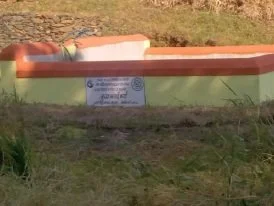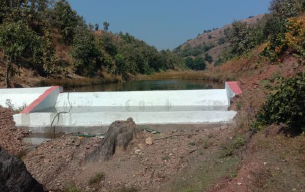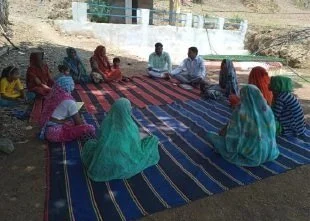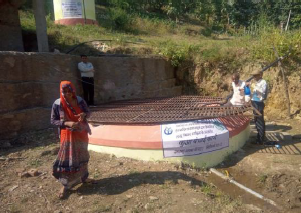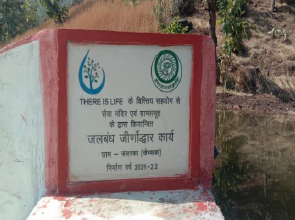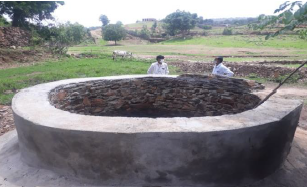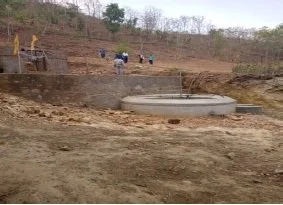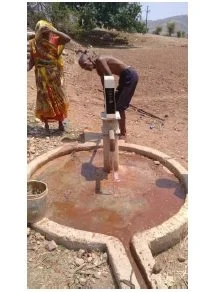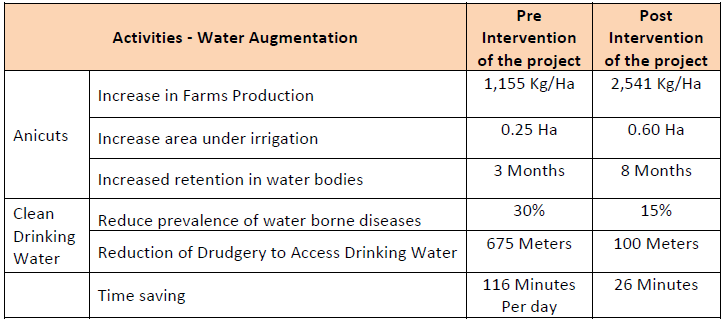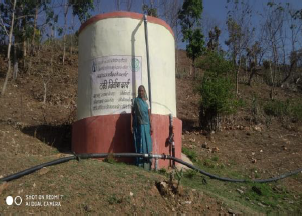Jalpaka Village
Local NGO: Seva Mandir
Executive Summary
There is Life has generously supported Seva Mandir through Friends of Seva Mandir, USA to make a village water secured in southern Rajasthan. A support of $31,000 has been received for the project. The project is benefitting 1,475 people in Jalpaka village in Rishabhdev Block of southern Rajasthan. We are extremely grateful for this support.
The total project work includes repairing of 2 Water Harvesting Structures, 5 Well Restoration, 5 Tank Construction and 5 Hand Pump Repair.
The interventions will have long term impact on the rural and tribal communities of Jalpaka village as it has improved the overall water availability in the village, increased ground water level, it is providing safe drinking water facility to the villagers and also reduced the drudgery of women.
Project Work
The project has been taken up in Jalpaka village of Kherwara block. The Jalpaka village is quite interior and has hilly and staggered terrain. The occupation of most of the households is agriculture and wage labour. This area suffers acute water scarcity especially during summer. Women, who are primary responsible for collecting water, have to travel long distances to collect water for daily needs. However, during summer, many of the sources dry up which further increases women drudgery and there are also certain populations in remote hamlets who do not have access to even these sources. Poor availability of Clean Drinking Water (CDW) is a direct cause for innumerable problems for local communities and its deficiency further increases the vulnerability of families and reduces the chances of moving out of poverty. Due to the unprotected water sources in the village, the water contamination is very high, which results in various water borne diseases among villagers, especially children.
Interaction with community members and training was done before the initiation of the work. Based on the need and preparation of community to take accountability of the facilities created, Jalpaka village was selected.
The project has covered all the hamlets of Jalpaka village especially interior. The project is also indirectly benefitting other ongoing Seva Mandir programmes in the area, thus the project has created larger positive impact on the lives of people.
According to the baseline done in the area- the average distance walked to collect water per round is 362 meters which takes around 30 minutes. Women typically have to make 2-3 rounds per day to fetch water required for daily domestic use.
Also, the prevalence of water borne diseases in the communities is 62%. Post intervention, the distance travelled by women is planned to decrease from 362 to 80 meters, therefore, reducing the drudgery of women besides improving availability of water. Similarly, prevalence of water borne diseases is planned to reduce from 62% to 56%.
Activities Undertaken
1. Restoration work on 5 wells is completed. Because of restoration of wells, water is now not getting contaminated because of rain water and due to water handling practices, reducing the risk of water borne diseases. Also, now the wells are not risky for women and children who are primarily responsible for collecting water from these wells.
2. Repairing of 2 Anicut (Water Harvesting Structure) is completed. The repairing will prevent leakage, and therefore, water will be retained for longer period of time. This means, more water will be penetrated in the ground, improving ground water table and also recharging 15 wells in its downstream. Having water in the structure and wells will not only improve access to drinking water but will also help local farmers take multiple crops due to availability of water for irrigation. Additionally, now more water will be available for livestock. The structure will benefit 120 families (600 people) with improved access to water for drinking and their livelihood.
3. Construction of 5 water tank is completed. 100 families (500 people) are getting benefits of this tank. Water is filled and then chlorination is done to remove bacterial contamination from the tank, which helps in preventing various water borne diseases. Villagers are now getting 24 hrs water facility near their homes and it has reduced the drudgery of women, which has made their lives easier. The constructed tanks are now managed by the women of SHG group, every month they collect Rs. 20 from each family to meet the maintenance and other running costs.
4. Repairing of 5 hand pumps is completed. 75 families (375 people) are getting benefits of these hand pumps. The hand pumps were repaired as they were not functional earlier, due to various technical reasons. People are now getting drinking water facility near their homes and it has reduced the drudgery of women, which has made their lives easier.
Project Impact & Benefits
Seva Mandir has implemented several initiatives in the Jalpaka gram panchayat area to address water scarcity issue and to improve agricultural practices. Through this project of repairing 2 anicuts (water harvesting structure), renovation of 5 wells, construction of 5 water tanks, and repairing of 5 hand pumps, Seva Mandir has successfully increased the availability of water resources in the region.
The impact of these interventions has been significant. Previously, only a handful of people in the area undertook cultivation even during the Kharif season due to the scarcity of water. However, as a result of the increased availability of water, the number of households involved in Kharif cultivation has significantly increased. This has resulted in the cultivation of an additional 15 hectares of land in the area. Also during the Rabi season, wheat production increased from 2-3 quintals to 5-6 quintals, improving the livelihoods of the local farmers and increasing the availability of fresh produce for the community. Most importantly, there were around 15 families who were able to cultivate vegetables, lentils etc. during the summer season (Zaid crop).
Earlier, the villagers had to collect drinking water from naturally occurring water bodies such as lakes and rivers. Also, when water gets dried up in extreme summer, they collect water from veris (which are holes dug in dried-up river beds and lakes to collect water). However, such water bodies were likely to get polluted, particularly during the summer season as both wild and domestic animals depended on them, leading to increased chances of water-borne diseases among the villagers. Moreover, these water bodies were often located near forests, which raised the risk of wild animal attacks. The rainy season also brought its own set of challenges, with water becoming muddy due to soil erosion from the surrounding hills. After building 5 drinking water systems and repairing of 5 hand pumps by Seva Mandir, each well now serves around 175 families. As a result, there has been a significant decrease in the incidence of water-borne diseases, and the burden of women who had to travel long distances to fetch water has been alleviated.
Thus, the intervention has a transformative impact on the lives of the villagers, ensuring their access to safe and clean water for drinking as well as irrigation purposes. It has not just improved the availability of water but has also increased the awareness levels of the villagers and promoted sustainable agricultural practices in the region.
Project Sustainability
Management systems were set and it is assured to have total community participation in the work, which in long-term will help in sustainability of the project.
A major aspect of sustainability comes through community contribution in the form of labor and procuring local materials to build such systems. A nominal monthly fee from each beneficiary family is collected to create a management fund which is used to meet the expense of regular repair and maintenance.
The families contributed stones, and 20% of their labour cost in the Village Development Fund which later will help in sustaining the project.
Post construction work will be maintained by the women Self Help Groups. Per family from the village will contribute Rs. 20 to Rs. 30 per month.
There is Life, Seva Mandir, and the People of Jalpaka Village would all like to thank the people who donated to this project. Their contribution made this project possible.
Restored Well
Anicut (Water Harvesting Structure) repaired
Stand Post Constructed
Community Meeting
Well Restoration Work Site (Before)
Well Restoration Work Site (Before)
Well Restoration Work Site Nichla Magra (Before)
Repair work of Gabber Fala Water Harvesting Structure (Before)
Repair Work of Hand Pump
Restored Well
Tank Constructed
Stand Post Constructed
Project Details at the Site
Well Restoration Work Site (After)
Well Restoration Work Site (After)
Well Restoration Work Site Nichla Magra (After)
Repair work of Gabber Fala Water Harvesting Structure (After)
Repair Work of Hand Pump
Project Impact & Benefits
